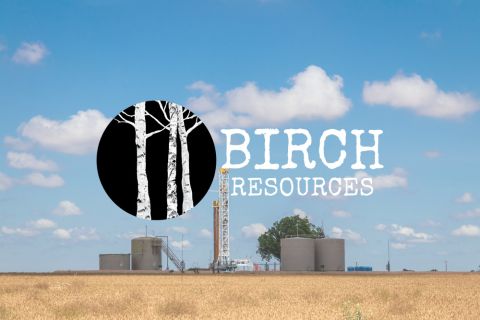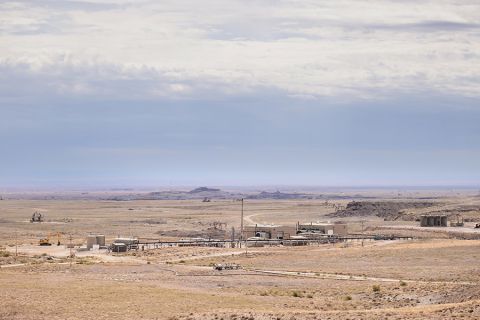More of today's private-equity firms, institutional investors and master limited partnerships (MLPs) are investing higher dollar amounts in midstream ventures. The opportunity to balance portfolios of risky, depleting E&P assets with longer-lived midstream assets-especially certain gas-gathering and -processing systems-is one many savvy investors are reluctant to pass up. This is fortunate since, due to increased U.S. drilling, midstream companies need more capital to build or expand their infrastructure, especially to handle new gas production in active areas such as the Barnett Shale and the Rockies. According to Ron Londe, the MLP securities analyst at A.G. Edwards & Sons, in 2005 there were a combined 42 midstream initial public offerings (IPOs) and follow-on offerings that raised $5.2 billion. Last year, IPOs increased the number of midstream MLPs to 26 from 21. The total market cap for midstream MLPs is now about $51.4 billion, thanks to these transactions, acquisitions and internal growth, he says. The latest midstream MLP to debut? Regency Energy Partners LP, Dallas, which went public on the Nasdaq National Market in January, raising about $258 million. "This is an efficient way for the public to help finance the infrastructure this country needs, because there's a limit to how much debt a company can take on," says Jim Hunt, Regency chairman and chief executive. Prominent Dallas-based investor HM Capital Partners LLC (formerly Hicks Muse) owns 62.7% of Regency post-IPO and 100% of the general partner, Regency GP LP. The group views Regency as a platform for further growth in the midstream. Regency was formed in 2003 and grew by acquisitions of midstream assets from El Paso Energy and Duke Energy. But now it is growing organically. Due to pipeline restraints in North Louisiana where gas production is growing, the MLP just quadrupled the capacity of its pipeline there in December 2005, to 800 million cubic feet of throughput a day. The "anchor tenant" on the expanded system is Anadarko Petroleum Corp.'s huge Vernon gas field. Regency intends to "lead with organic growth," says Hunt. "We're less interested in paying high multiples of eight, 10 or 12 times EBITDA (earnings before interest, taxes, depreciation and amortization). Any acquisition must be accretive. We're amazed by some of the high multiples [some others have been paying recently]." The MLP likes to get ahead of the curve. In more than one instance, it has ordered pipe and obtained pipeline rights of way before the wells that will hook up to the system have even been drilled. Regency and other midstream companies are beneficiaries today of continued favorable market conditions. T. Frank Murphy, managing director of investment banking at A.G. Edwards, says, "The average MLP is yielding 6.5% today, which translates into an average valuation multiple above 12 times 2006 EBITDA." The pick-up in energy MLP IPO activity in 2005 was due to very low interest rates, very attractive valuations and the impact of a number of industry private-equity sponsors finally recognizing that the MLP has a competitive advantage in the midstream arena, he says. "These sponsors want to take advantage of the MLP market as a value-creation method or as a competitive tool." Examples of new public midstream MLPs include TransMontaigne Partners LP, Williams Partners LP, DCP Midstream Partners and Boardwalk Pipeline Partners. Most, if not all, of the follow-on offerings in A.G. Edwards' midstream universe have been oversubscribed, Londe adds. George Morris, an investment banker with Petrie Parkman & Co., says that also driving midstream IPOs today is an increased desire of the general partner to monetize. "In the past, general partners were not as liquid," Morris says. "Now we have deal after deal and several IPOs of general partners and you're able to monetize your subordinated units." By going public, a midstream MLP in effect "sells" a portion of its excess cash flow to public unit-holders. The split of cash flow between the general partner and the limited partners affects the latter's returns. But in some cases, these MLPs are taking their general partner public too. The increased activity is giving the market a lot to digest in 2006, says Craig Kogan, managing director at Dallas-based Energy Spectrum Capital, which makes private-equity investments in midstream companies. "We're now seeing some hiccups in that the recent IPOs are not taking off the way last year's IPOs did. But it's likely to be temporary. The market for this kind of product is attractive, and these companies need additional capital to grow." Darrell Holley, Dallas-based managing director of Fortis Capital Corp.'s global oil and gas group, says, "The midstream is becoming a more defined subsector, which provides incentives for private-equity providers and MLPs to invest their capital, similar to what they've done with long-lived assets in E&P." Pipeline-capacity contracts are more predictable, less price-sensitive structures-where risk is shared more equitably. "As a result, the investors see a good opportunity to participate in a very robust commodity environment. It just makes for more quantifiable future cash flow," Holley says. After certain rates of return and distributions to unit-holders, the general partner typically receives a disproportionate share of the marginal distributed dollar-strongly motivating MLPs to grow. Acquisition and organic growth are key to building their cash flow available for distributions. Kogan says, "Private-equity groups are interested in midstream assets because they provide a great growth platform, generate cash flow to support leverage and can be sold to either hungry MLPs, companies planning to go public or by doing an IPO directly." Morris says, "The midstream market is so active that private-equity groups are even buying midstream assets from other private-equity groups. It used to be if private equity was selling assets, the assumption was that there was something wrong with them, but now that stigma has gone away." Some private-equity players are on the midstream sidelines, but not by choice. "There is not a huge demand for private capital because of current liquidity levels and the robust public markets," Holley says. "Midstream companies don't have to go after private equity and give away what they feel is a disproportionate share of the company." In the past, the public markets haven't always been there for the midstream sector because of the challenge in figuring predictable cash flow, Holley says. But contracts between the midstream companies and producers have changed, and investor appetite is growing. "You could argue that some investors would feel safer and have a more predictable profile investing in midstream versus E&P. If you look at certain midstream operations in a single company you can get diversity. At the same time you're benefiting from major capital expenditure plays by E&P companies active in their service area that give you upside and growth. That's more diverse than investing in a single E&P company." High multiples Why the high multiples? Buyers have strong convictions about growth expectations, there's plenty of capital available and interest rates are low, Kogan says. Given the tax-advantaged structure of MLPs driving their low cost of capital, they can afford to pay nine to 11 times for assets and still have an accretive deal, he adds. Londe forecasts midstream MLPs will spend about $6 billion on capital improvements in 2006. "You'll see capital coming from mutual funds and other institutions. Numerous midstream acquisitions will happen this year, but I think you'll still see more growth from internal projects." He also expects more private-equity money to get in the midstream business. "We just saw EnCana Corp. sell $1.5 billion in natural gas-storage assets to a private-equity firm [Riverstone Holdings LLC and The Carlyle Group]. Eventually, you'll also see a consolidation among the MLPs." Organic growth is an attractive alternative to pricey acquisitions in the midstream, since it can be done at multiples of four to seven and is therefore expected to continue, Kogan says. M&A activity will nonetheless remain robust. "There's always the fear that we're at the edge of the cliff, so some companies that have midstream assets that are not core may start to feel left out and begin searching for sales. There will definitely be buyers out there in 2006." Hot spots for growth are popular E&P plays: midstream companies can just follow the rigs, because new production always requires more infrastructure, Morris says. "So what you're going to see are super-high multiples to buy into those areas, with the theory being 'Pay a pretty penny to buy into it, but average it down by building it out.'" Murphy says prices have been bid up. "Three years ago, you could buy midstream assets for seven to nine times EBITDA and the market was valuing MLPs at 10 to 12 times. Today, it's difficult to buy midstream assets at under 10 times EBITDA. More buyers want assets that can connect with their existing systems or they have some competitive advantage that allows them to pay an aggressive price, then lower the multiple by adding value to the asset." Holley anticipates more midstream expansion, as the MLP structure is "an animal that you have to continue to feed. Growth for the sake of growth will continue because that's what drives the increased distributions [that investors expect]. And since you almost have an infrastructure that's at capacity here in the U.S., I don't think it can help but grow."
Recommended Reading
Hot Permian Pie: Birch’s Scorching New Dean Wells in Dawson County
2024-10-15 - Birch Resources is continuing its big-oil-well streak in the Dean formation in southern Dawson County with two new wells IP’ing up to 2,768 bbl/d.
Matador’s U-lateral Delaware Tests Outproduce 2-mile Straight Holes
2024-10-30 - Matador Resources' results from eight Loving County, Texas, tests include two 2-mile U-turn laterals, five 2-mile straight laterals and one 1-mile straight lateral, according to state data.
Northern’s O’Grady: Most of ‘Best’ Acres ‘Already Been Bought’
2024-10-24 - Adding new-well inventory going forward will require “exploration or other creative measures,” said Nick O’Grady, whose Northern Oil and Gas holds interests in 10,000 Lower 48 wells.
Now, the Uinta: Drillers are Taking Utah’s Oily Stacked Pay Horizontal, at Last
2024-10-04 - Recently unconstrained by new rail capacity, operators are now putting laterals into the oily, western side of this long-producing basin that comes with little associated gas and little water, making it compete with the Permian Basin.
Exxon Plans Longest 20,000-Ft Wells on Pioneer’s Midland Asset
2024-11-04 - Exxon Mobil has already drilled some of the longest wells in the New Mexico Delaware Basin. Now, the Texas-based supermajor looks to go longer on Pioneer’s Midland Basin asset.
Comments
Add new comment
This conversation is moderated according to Hart Energy community rules. Please read the rules before joining the discussion. If you’re experiencing any technical problems, please contact our customer care team.





